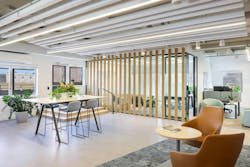Several new projects are upgrading historic Princeton, N.J.
By John Caulfield, Senior Editor
Princeton, New Jersey, which can trace its past to a settlement established in 1675, is now a borough with 30,000 residents that has managed to maintain its walkable, small-town historic feel while continuing to grow and upgrade with construction and infrastructure improvements.
Recent projects have included the American Campus Communities-developed Meadows Graduate Housing complex serving Princeton University, whose Building Team was led by the engineering firm Thornton Tomasetti, the design firm Mithun, and CM Hunter Roberts. The 329,000-sf, three-building project, located in the suburb of West Windsor, has 379 units that are Passive House-designed and will use district geothermal-exchange for heating and cooling. This project is part of the university’s broader goal to be net-zero carbon emissions by 2046.
The university continues apace on its new Art Museum, designed by the architect David Adjaye. The 145,000-sf building, located in Princeton’s downtown, is scheduled to open by early 2025. LF Driscoll has been leading the construction of the nine-pavilion museum, which will have 300 percent more educational space and 65 percent more exhibit space than the facility it is replacing. (The original museum was built in 1923.)
Designed with a ‘neighborhood’ concept
Sweetwater Construction Corp. recently wrapped up construction on another downtown project: the new office location for Amicus Therapeutics, a patent-dedicated biotech company that develops medicines for rare diseases.
This 27,200-sf space, for which Ware Malcomb provided interior architecture and design services, encompasses the fourth and fifth floors of the five-story, 71,500-sf Class A office building at 47 Hulfish Street, which was built in 1985.
This space will serve as Amicus’ global headquarters. The office is open, contemporary, and designed with a neighborhood concept. A common core promotes connectivity between the flexible office areas that surround it. The office features large angled baffled designs with integrated lighting that is strategically deployed as acoustical elements.
“We focused on creating a space that built upon Princeton’s community feel, as well as addressing Amicus’ desire for flexible workspaces and convenient amenities,” said Marlyn Zucosky, Ware Malcolm’s Regional Director, in a prepared statement. She added that the interior design focuses on “creating a sense of belonging and inspiration.”
Graphics convey the patient’s journey
Enclosed meeting rooms within Amicus’ new space double as offices, and larger meeting rooms have movable walls to provide flexibility. Ceilings were extended beyond enclosed spaces to the adjacent collaboration areas, which maximized square footage usage and created a sense of openness and unity.
The project team incorporated branded storytelling graphics into the boardroom area, unassigned mobile workstations and collaboration areas. The branding and graphic elements highlight the patient’s journey and underscore the interconnectedness between corporate objectives and the human element. The entire space also integrates elements of biophilia and neurodiversity, along with sustainable practices to enhance connectivity to nature and contribute to a healthier indoor environment.


